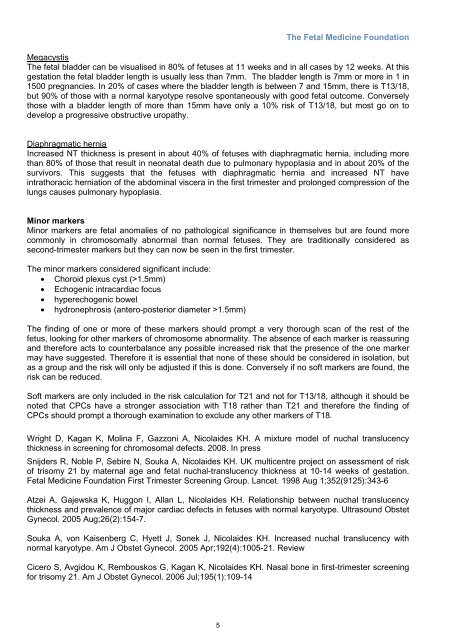Fetal Medicine Foundation First Trimester Screening
Fetal Medicine Foundation First Trimester Screening
Fetal Medicine Foundation First Trimester Screening
You also want an ePaper? Increase the reach of your titles
YUMPU automatically turns print PDFs into web optimized ePapers that Google loves.
The <strong>Fetal</strong> <strong>Medicine</strong> <strong>Foundation</strong><br />
Megacystis<br />
The fetal bladder can be visualised in 80% of fetuses at 11 weeks and in all cases by 12 weeks. At this<br />
gestation the fetal bladder length is usually less than 7mm. The bladder length is 7mm or more in 1 in<br />
1500 pregnancies. In 20% of cases where the bladder length is between 7 and 15mm, there is T13/18,<br />
but 90% of those with a normal karyotype resolve spontaneously with good fetal outcome. Conversely<br />
those with a bladder length of more than 15mm have only a 10% risk of T13/18, but most go on to<br />
develop a progressive obstructive uropathy.<br />
Diaphragmatic hernia<br />
Increased NT thickness is present in about 40% of fetuses with diaphragmatic hernia, including more<br />
than 80% of those that result in neonatal death due to pulmonary hypoplasia and in about 20% of the<br />
survivors. This suggests that the fetuses with diaphragmatic hernia and increased NT have<br />
intrathoracic herniation of the abdominal viscera in the first trimester and prolonged compression of the<br />
lungs causes pulmonary hypoplasia.<br />
Minor markers<br />
Minor markers are fetal anomalies of no pathological significance in themselves but are found more<br />
commonly in chromosomally abnormal than normal fetuses. They are traditionally considered as<br />
second-trimester markers but they can now be seen in the first trimester.<br />
The minor markers considered significant include:<br />
• Choroid plexus cyst (>1.5mm)<br />
• Echogenic intracardiac focus<br />
• hyperechogenic bowel<br />
• hydronephrosis (antero-posterior diameter >1.5mm)<br />
The finding of one or more of these markers should prompt a very thorough scan of the rest of the<br />
fetus, looking for other markers of chromosome abnormality. The absence of each marker is reassuring<br />
and therefore acts to counterbalance any possible increased risk that the presence of the one marker<br />
may have suggested. Therefore it is essential that none of these should be considered in isolation, but<br />
as a group and the risk will only be adjusted if this is done. Conversely if no soft markers are found, the<br />
risk can be reduced.<br />
Soft markers are only included in the risk calculation for T21 and not for T13/18, although it should be<br />
noted that CPCs have a stronger association with T18 rather than T21 and therefore the finding of<br />
CPCs should prompt a thorough examination to exclude any other markers of T18.<br />
Wright D, Kagan K, Molina F, Gazzoni A, Nicolaides KH. A mixture model of nuchal translucency<br />
thickness in screening for chromosomal defects. 2008. In press<br />
Snijders R, Noble P, Sebire N, Souka A, Nicolaides KH. UK multicentre project on assessment of risk<br />
of trisomy 21 by maternal age and fetal nuchal-translucency thickness at 10-14 weeks of gestation.<br />
<strong>Fetal</strong> <strong>Medicine</strong> <strong>Foundation</strong> <strong>First</strong> <strong>Trimester</strong> <strong>Screening</strong> Group. Lancet. 1998 Aug 1;352(9125):343-6<br />
Atzei A, Gajewska K, Huggon I, Allan L, Nicolaides KH. Relationship between nuchal translucency<br />
thickness and prevalence of major cardiac defects in fetuses with normal karyotype. Ultrasound Obstet<br />
Gynecol. 2005 Aug;26(2):154-7.<br />
Souka A, von Kaisenberg C, Hyett J, Sonek J, Nicolaides KH. Increased nuchal translucency with<br />
normal karyotype. Am J Obstet Gynecol. 2005 Apr;192(4):1005-21. Review<br />
Cicero S, Avgidou K, Rembouskos G, Kagan K, Nicolaides KH. Nasal bone in first-trimester screening<br />
for trisomy 21. Am J Obstet Gynecol. 2006 Jul;195(1):109-14<br />
5
















